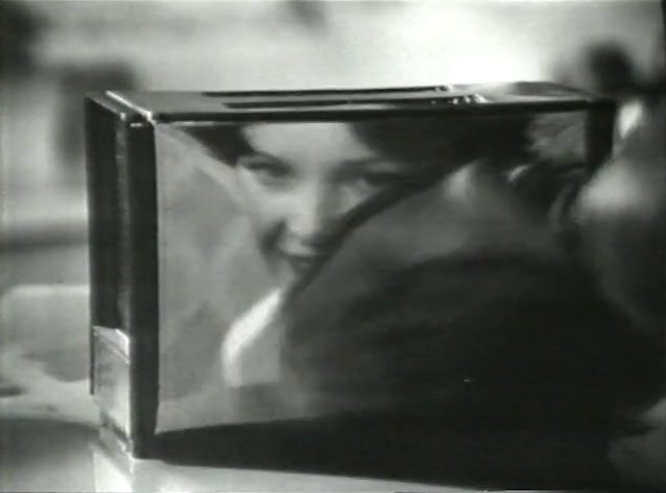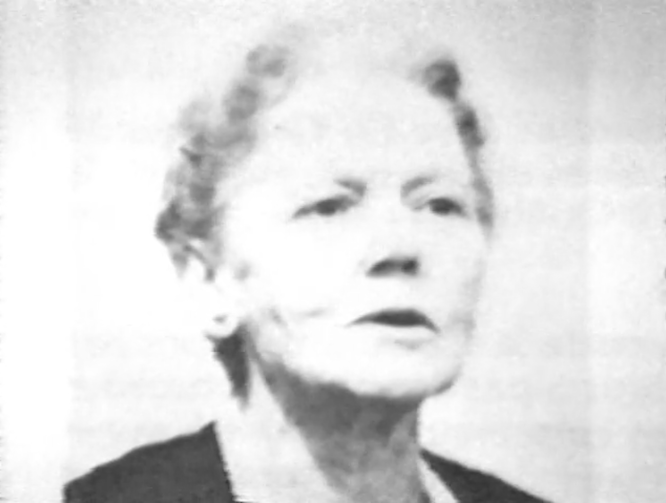

:: Femmes de rêves (Louise Gendron, 1978) [GIV]
Media artworks lead mostly unsupervised lives. What do they do when they are not being presented to a viewer or viewers? How does one accompany a work apart from showing it? Sometimes, media artworks are abandoned and forgotten. Sometimes, there is a happier outcome and they may be labelled ‘seminal’. Most works reside in an in-between state, moderately successful for a year or two, then stored on shelves (upright, of course, in the case of physical tape formats). Some may exist in fragments, victims of tape deterioration. Some happen to be the early works of a renowned artist and are delighted to bask in the sudden glow of recognition. Some works end up representing an entire decade of production, or become examples of a school of video practice. Some await rediscovery.
Groupe Intervention Vidéo (GIV) tries to propose a brief series of respites from this state of affairs by offering diverse programming activities.
GIV is approaching its 50th anniversary. Founded in 1975, a time in which political activism and artistic practice were particularly fused, one of the formative ideas that motivated the first GIV team was to ensure that video was a tool for social change. This can be seen in some of the videos created in the early years of GIV such as Femmes de rêve (Louise Gendron, 1978) and Mémoire d’octobre (Jean-Pierre Boyer, 1979). The video medium was used in the seventies to provide, for example, a marxist deconstruction of a popular show, Rue des pignons (1966-1977) (Ceci est un message de l'ideologie dominante, Michel Sénécal and Michel Van de Walle, 1975) or to outline in fiction and documentary sections the problems faced by women contemplating abortion (Partir pour la famille, Hélène Bourgault, 1974).

:: Partir pour la famille [GIV]
In many video histories (so markedly different regionally), it is possible to glimpse visions of utopia evident in certain productions and texts (and production/distribution centres) from the early years of the medium. There were several promises in the air. One was that cable stations would become reflections of the community (ies) by, in part, broadcasting video tapes being made by independent producers. Another was the promise of using the dissemination of videos as education for change. In Quebec, founders of GIV, Vidéographe, Coop Vidéo and Vidéo Femmes [ndlr: the collective folded in 2015 through its fusion with Spira], just to name a few centers, often made tapes with and for communities. When the videos, usually documentaries or docu-fictions, were completed, they were shown first to the people closest to the content ; striking workers, single mothers, union members. The participants were asked to critique the images they saw and contribute to the final edit. Videotape became, in part, a strategic tool meant to reflect the lives of participants. The sense of utopia was reflected in the process (making works collectively) and the product (focusing on problems and solutions to influence social change). The promise of the utopian use of the medium has faded, but essential traces remain. Videos are still made to advocate, expose and explain social ills.
This tenuous sense of building a utopia was part of the zeitgeist in the 1970s. There was a brief time during which tapes were shown and seen regularly in places that have long since given up the practice due to budgetary cuts. Tapes flickered in church basements (doubling as community centres), womens' centres and MDJ's (Maison de Jeunes, a network of youth centres across Quebec). Show the world what it does not know. Show the world what technology can do.
In some ways, presenting videos from every decade of video history is an attempt to trace the evolution from what was once possible technically to technical possibilities in the production of video. Sometimes, upon viewing videos from the seventies, there is a palpable feeling of exhilaration, a tactile sensation that an artist is surpassing and even incorporating the technical limitations of early production methods. In a sense, choosing older works is about having a specific feeling for tapes, older and recent, that slammed onto monitors and screens with energy and vigour that echo still.
For these quasi-mystical reasons that celebrate the alchemy of curatorial creation, GIV programming activities are designed to be components of a multilevel and multipurpose approach to presentation. GIV staff is interested in creating diverse exhibition contexts. GIV presents media artworks in parks, in our office presentation space, in formal exhibition spaces (Cinémathèque Québécoise, festival screenings, Maison de la culture Plateau-Mont-Royal), in community and women’s’ centres and in collaboration with other artist-run centres. We pay special attention to the creation of contexts in which discussion and exchange are encouraged. We create and produce multiple activities that attract diverse audiences: young adults, general public, artists, curators, educators, students, and media.

:: Femmes de rêves (Louise Gendron, 1978) [GIV]
GIV organizes five recurring curated series: Vidéos de femmes dans le parc (VFP), La voûte/The Vault, Laissez-Passer, Topovidéographies and Une œuvre vit quand elle est aimée. Each of the five programming series is intended to provide a unique context for the presentation of artworks and artists. In the busy Montreal arts presentation context, we feel it is important for us to provide an environment that does not simply reproduce others. We can provide an intimate setting for an artist or artists (or staff curators) to do ‘something’ — present her own or another’s’ work, show a work-in-progress, curate a program, have a discussion.
Vidéos de Femmes dans le Parc offers a yearly glimpse of independent video production by women with an event that is ideal for newcomers and core audience members alike. The name of the event was strategically chosen as a straightforward description. At the first edition in 1991, VFP was the only event dedicated to the work of women media artists in Montreal. In 2021, VFP is still one of the only events of its kind. The simple name was also chosen to provoke discussion. While spectators are invited to see ‘videos by women’, the works they will see are representative of diverse directions/genres/themes undertaken by media artists.
The Vault/La voûte is a program that begins as an open call submission on a particular theme. There are no imposed restrictions as to years of production. We developed The Vault for key reasons: to show works from all decades of video production, to work thematically, and to suggest new contexts for looking at works. The inaugural screening, held in March 2007, was simply called The Vault and was on the theme of archives and preservation. This first program was made up of works ranging in production dates from 1973 to 2004. The Vault is a program that counteracts the fact that most festival screenings focus on recent work.
Laissez-Passer is the title of an ongoing carte blanche invitation GIV makes to an artist, a curator or professional working in film and/or video, new media or audio. Laissez-Passer takes place in our office space. While Laissez-Passer contains elements of prescribed presentation, we encourage exchange between artist and public by hosting a reception after the talk and/or screening. The Laissez-Passer program is flexible, adapting to each invited artists’ interpretation of what a carte blanche symbolises.
Topovidéographies focuses on the presentation of video programs made up of the work of several artists. This program is quite often the result of a collaboration with curators and/or artists. Geography(ies) and location are important themes. Topovidéographies is a program that allows us to consider works from countries other than Canada as chosen by an artist or curator. Past programs in this series have paired Quebec and Swiss video works and showcased Portuguese productions. This program was developed to invite measured reflection on independent video productions created in countries other than Canada.

:: Histoires des luttes féministes au Québec (Nicole Giguère, 1980) [GIV]
« Une oeuvre vit quand elle est aimée/A work lives when it is loved » is a program we developed with curator and writer Nicole Gingras. Gingras chooses an artist with whom she would like to work. She chooses one media artwork by that artist. During the presentation, the work is shown once at the beginning of the presentation and again at the end. In between, Nicole and the artist talk about the work in question and take questions from the audience. This program was developed to spend more time on one media artwork. Curators sometimes accompany artworks in the broadest sense of the word. In these cases, they do not merely select and present videos. They do not simply write about productions. They carry works along with them. They try to make works live beyond a screening and further than a text. They bring them everywhere all the time. These curators aim for a kind of transmission, sharing the work and the ideas they identify as intrinsic to it.
Within the spaces created by individual artworks, viewers may experience the resonance of separate worlds. Each artist creates a pure, unique universe populated by specters of their own makings and imaginings. We only have to step over the tenuous thresholds to apprehend palimpsests, the ghost-like, the ghostly, the haunted, the haunting, and ethereal traces of perception. The creation of different kinds of presentation practices reflects the attempt to engender the peculiar alchemy of curating and the ever-changing experience of viewing works.
*
Anne Golden is an independent curator and writer whose programs have been presented at Musée national des beaux-arts du Québec, Edges Festival and Queer City Cinema, among others. She has written for FUSE and Canadian Theatre Review. Golden has participated in numerous panels on curatorial practices, independent distribution and, more recently, horror films.Golden is Artistic Director of Groupe Intervention Vidéo (GIV). She teaches in the Media Arts Department of John Abbott College.Golden has made twenty videos including Fat Chance (1994), Big Girl Town (1998), From the Archives of Vidéo Populaire (2007) and The Shack (2013).
 |
envoyer par courriel | 
| imprimer | Tweet |
